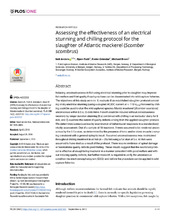| dc.contributor.author | Anders, Neil | |
| dc.contributor.author | Roth, Bjørn | |
| dc.contributor.author | Grimsbø, Endre | |
| dc.contributor.author | Breen, Michael | |
| dc.date.accessioned | 2019-11-19T09:51:40Z | |
| dc.date.available | 2019-11-19T09:51:40Z | |
| dc.date.issued | 2019-09-04 | |
| dc.Published | Anders N, Roth B, Grimsbø E, Breen M. Assessing the effectiveness of an electrical stunning and chilling protocol for the slaughter of Atlantic mackerel (Scomber scombrus). PLOS ONE. 2019;14(9). | eng |
| dc.identifier.issn | 1932-6203 | en_US |
| dc.identifier.uri | http://hdl.handle.net/1956/21008 | |
| dc.description.abstract | Inducing unconsciousness in fish using electrical stunning prior to slaughter may improve fish welfare and fillet quality if such practises can be disseminated into wild capture fisheries. The objectives of this study were to: 1) evaluate if an established slaughter protocol consisting of dry electrical stunning (using a coupled AC/DC current at ≈ 110 Vrms) followed by chilling could be used to stun the wild captured species Atlantic mackerel (Scomber scombrus) unconscious within 0.5 s; 2) determine if death could be induced without consciousness recovery by longer duration stunning (5 s) combined with chilling in an ice/water slurry for 6 min; and 3) examine the extent of quality defects arising from the applied slaughter protocol. We determined consciousness by examination of behavioural responses in a standardised vitality assessment. Out of a sample of 10 mackerel, 9 were assumed to be rendered unconscious by the 0.5 s stun, as determined by the presence of tonic and/or clonic muscle cramping consistent with a general epileptic insult. Assumed unconsciousness was maintained throughout chilling treatment in all fish (n = 25) following a full stun of 5 s. All fish were assumed to have died as a result of the protocol. There was no evidence of spinal damage or haematoma quality defects post filleting. These results suggest that the examined protocol is effective at slaughtering mackerel in a manner consistent with good welfare and without inducing quality defects, but further research is required to verify the unconscious condition via electroencephalogram (EEG) and before the procedure can be applied in wild capture fisheries. | en_US |
| dc.language.iso | eng | eng |
| dc.publisher | Public Library of Science | en_US |
| dc.rights | Attribution CC BY 4.0 | eng |
| dc.rights.uri | http://creativecommons.org/licenses/by/4.0/ | eng |
| dc.title | Assessing the effectiveness of an electricalstunning and chilling protocol for theslaughter of Atlantic mackerel (Scomber scombrus) | en_US |
| dc.type | Peer reviewed | |
| dc.type | Journal article | |
| dc.date.updated | 2019-10-08T06:35:57Z | |
| dc.description.version | publishedVersion | en_US |
| dc.rights.holder | Copyright 2019 Anders et al. | en_US |
| dc.identifier.doi | https://doi.org/10.1371/journal.pone.0222122 | |
| dc.identifier.cristin | 1734746 | |
| dc.source.journal | PLOS ONE | |
| dc.relation.project | Fiskeri- og havbruksnæringens forskningsfinansiering: 15130 | |
| dc.relation.project | Norges forskningsråd: 203477 | |

